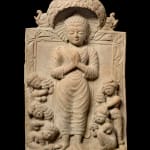


Unknown
Plaque with standing Buddha and five devoties, 3rd/4th century
Eastern India, Bengal
Terracotta
Terracotta
40.5 x 25 x 7 cm
Base: 47.5 x 34 x 14 cm
Base: 47.5 x 34 x 14 cm
Further images
Terracotta was a traditional medium for sculptors in the Ganges Valley and in Bengal these skills were perfected in the late centuries BCE, into the early centuries CE. Clay plaques...
Terracotta was a traditional medium for sculptors in the Ganges Valley and in Bengal these skills were perfected in the late centuries BCE, into the early centuries CE. Clay plaques were made for both domestic and community worship.
This elegant composition dating from the 3rd or 4th century combines elements of regional and more universal style. The Buddha wears a finely draped robe that covers both shoulders and falls in gentle folds, modestly enveloping his body, but at the same time drawing attention to the perfection of his physique. So delicate is the modelling of the clay that a realistic impression is given of a fine, soft fabric that appears to move as its wearer breathes, thereby animating an otherwise static figure.
The Buddha’s robe follows the concept developed in Gandhara in the 1st/2nd centuries, that spread eastwards, first to the city of Mathura, Uttar Pradesh where there was a prosperous Buddhist community, and from there to Bihar and Bengal. The coins of the Kushan Empire, carrying images of the Buddha were probably responsible for the transmission of the style from west to east. The appearance of his devotees, however, maintains an existing Bengali tradition; they are dressed in the finely pleated garments, turbans and copious jewellery seen in images of regional deities over several hundred years. In the context of this plaque, their finery is a metaphor for their spiritual excellence, hence their presence in close proximity to the Buddha.
At the top of the plaque, the leaves of the Bodhi tree, beneath which the Buddha attained Enlightenment, form a canopy over his head. Two elephant heads further identify him; he was conceived when his mother, Mayadevi, dreamt of an elephant.
This elegant composition dating from the 3rd or 4th century combines elements of regional and more universal style. The Buddha wears a finely draped robe that covers both shoulders and falls in gentle folds, modestly enveloping his body, but at the same time drawing attention to the perfection of his physique. So delicate is the modelling of the clay that a realistic impression is given of a fine, soft fabric that appears to move as its wearer breathes, thereby animating an otherwise static figure.
The Buddha’s robe follows the concept developed in Gandhara in the 1st/2nd centuries, that spread eastwards, first to the city of Mathura, Uttar Pradesh where there was a prosperous Buddhist community, and from there to Bihar and Bengal. The coins of the Kushan Empire, carrying images of the Buddha were probably responsible for the transmission of the style from west to east. The appearance of his devotees, however, maintains an existing Bengali tradition; they are dressed in the finely pleated garments, turbans and copious jewellery seen in images of regional deities over several hundred years. In the context of this plaque, their finery is a metaphor for their spiritual excellence, hence their presence in close proximity to the Buddha.
At the top of the plaque, the leaves of the Bodhi tree, beneath which the Buddha attained Enlightenment, form a canopy over his head. Two elephant heads further identify him; he was conceived when his mother, Mayadevi, dreamt of an elephant.









